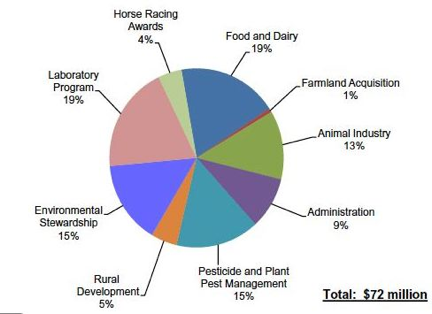By XINJUAN DENG
Capital News Service
LANSING — A proposal to increase state spending on the Michigan Agriculture Environmental Assurance Program (MAEAP) would reduce pollution from farm operations in the next few years, advocacy groups said.
The voluntary program helps farmers evaluate their operation and make them economically and environmentally sustainable. More than 1,000 verifications have occurred in the past decade.
The Snyder administration said the $1 million proposed for 2012-13 could pay off with five times that many verifications by 2015. If approved by the Legislature, it would almost double state funding for the program from this year’s $586,400.
Michigan Farm Bureau President Wayne Wood said the spending proposal is: “more evidence this governor is a man of his word and, on a more practical level, someone who appreciates the value of agriculture to the state’s economy without sacrificing a commitment to protecting our natural resources.”
The Farm Bureau is the state’s largest agricultural organization.
To become MAEAP-verified, farmers must complete three comprehensive steps: educational seminars, a thorough on-farm risk assessment, and development and implementation of an action plan addressing potential environmental risks.
James Johnson, the director of the Environmental Stewardship Division at the Department of Agriculture and Rural Development, said, “Verification can happen in one of three different systems. The farmstead system looks at what is happening around the farm, which would include buildings, pesticide and fertilizer storage, mix and load operations.
“The cropping system looks at what is happening in the fields and would include tillage, soil erosion, pesticide application, oil and crop rotation.
“The livestock system evaluates animal operations dealing with care, feeding, manure storage and handling, and land application,” he said.
He said the 1,100 farm verifications cover almost 700 farms because many have more than one verified operations.
In most cases, environmental risks are pollution to surface and ground water. Verifications examine operations’ potential impact on water, soil and air.
Hugh McDiarmid Jr., the communications director of the Michigan Environmental Council, said the budget recommendation “includes some encouraging steps in the right direction.”
The council, a coalition of local and statewide environmental groups, supports “greater emphasis on ensuring that agriculture has a minimal impact on our lakes and streams,” McDiarmid said. “The MAEAP program is one tool to help achieve this.”
Michigan’s conservation districts play an important role in MAEAP by providing local assistance to those interested in ensuring that their farm is environmentally sound. Districts work closely with farmers to identify environmental risks and offer technical assistance and conservation planning to address those risks.
Lori Phalen, executive director of the Michigan Association of Conservation Districts based in East Lansing, said, “Snyder’s proposed budget acknowledges the importance of agriculture and Michigan’s rural communities.”
She continued, “The increased funding proposed will provide the resources needed to engage more of Michigan’s farmers in the program.”
The increase in funding would bring some challenges to the program.
Johnson said there are two challenges in meeting the target of 5,000 verifications.
“The first is our ability to provide enough staff to work at the local level with farmers to identify and address environmental risks ,” he said. “The second challenge is the department’s ability to verify that all environmental risks have been properly identified and addressed.”
Johnson said, “This budget provides an opportunity for the department to direct efforts towards meeting these two challenges.”
Tonia Ritter, manager of the Farm Bureau’s state governmental affairs department, said her organization looks forward to working with the Legislature and Snyder administration during the budget process.
© 2012, Capital News Service, Michigan State University School of Journalism. Nonmembers cannot reproduce CNS articles without written permission.
Proposed Budget for Department of Agriculture and Rural Development
Source: Executive Budget for Fiscal Year 2013 and 2014

Spartan Newsroom - News and information from student journalists at the Michigan State University School of Journalism
Spartan Newsroom (https://news.jrn.msu.edu/2012/02/farm-program-expansion-could-reduce-pollution/)